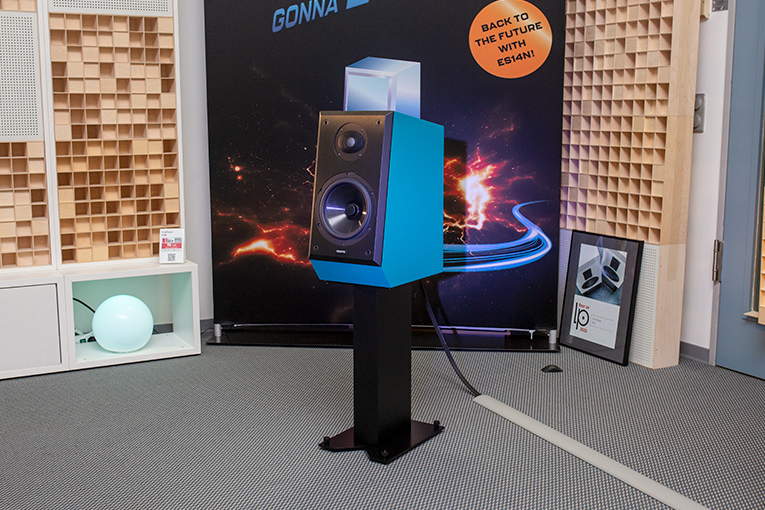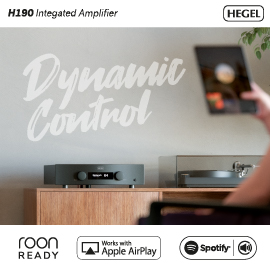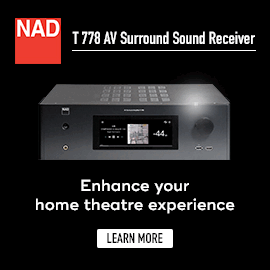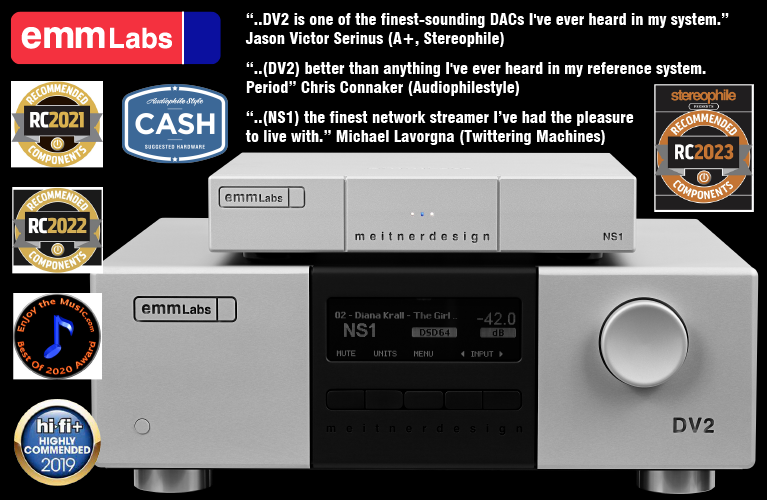After two years when hi-fi shows have been few and far between, 2022 saw them return in force. First, the Florida Audio Expo in Tampa, Florida, in February; then Canada’s Montreal Audiofest in March; in April, AXPONA in Chicago; and then, the focus of this article, High End in Munich, Germany, in May. No one from our team attended AXPONA, but I was at Florida Audio Expo with fellow-writer Jason Davis and then at Montreal Audiofest on my own, with the express purpose of providing coverage of those events for our SoundStage! Global site.
 Doug Schneider, Jonathan Gorse, Jeff Fritz, and Edgar Kramer
Doug Schneider, Jonathan Gorse, Jeff Fritz, and Edgar Kramer
The previous shows had been so successful that we decided to send a four-person team to Munich to cover High End 2022. The show was held from May 19 to 22 at the Munich Order Center, the same venue that’s been used for over 15 years. I was there with editor-in-chief Jeff Fritz, as well as UK correspondent Jonathan Gorse and SoundStage! Australia editor-in-chief Edgar Kramer. That’s not just a pretty big team, it’s an international one as well—which is fitting, because High End, more than any other hi-fi show in the world, is a truly international show both in terms of the exhibitors and the people attending.
High End is also the largest hi-fi show in the world, a title that the COVID-19 pandemic didn’t take away. But, from what I could tell, the event wasn’t quite as big as the last time it was held, in 2019—my best guess is that it was 80% of what it was then in terms of exhibitors and attendees. That said, the 2022 version was still far bigger than the other shows this year, and it was still too big for our team of four, despite working all day, every day, to comprehensively cover. We would’ve needed twice as many people in Munich, if not more, to cover every significant new product that was there.

Because of High End’s size and our considerable but still limited resources, the Best of High End 2022 products we are featuring here come with the caveat that that they were culled just from the ones we covered in our SoundStage! Global show report. It’s quite possible there were other great products on display that we didn’t get to see. Our picks are presented in the order that we covered them, not in terms of importance, and, with the lone exception of Monitor Audio’s Concept 50, are priced in euros—the show was in Germany, after all.
Gryphon Audio Designs Apex Stereo amplifier
High End 2022 wasn’t the first time that Gryphon’s Apex Stereo amplifier had been displayed publicly at a hi-fi show—it debuted at AXPONA. Furthermore, Jeff Fritz got one of the first Apex Stereo review samples shortly after it was announced in January and his SoundStage! Ultra review was published on May 1. But this was the first time I’d seen the Apex Stereo—and I found it a sight to behold, as well as too classy not to be included here.

Weighing around 450 pounds and priced at €82,500, the Apex Stereo is the largest, heaviest, most powerful, and most expensive stereo class-A amp that Gryphon has ever produced. That’s a lot of money even for a high-end hi-fi component, but when you see the Apex Stereo—and hear it, according to Jeff—you’d be hard-pressed to say it’s overpriced. As Jeff often likes to say, you get a lot of stuff for the money. I also find it strangely beautiful—the Apex Stereo is dark, menacing, and brutish-looking, which is typical of Gryphon’s products, but there is something just right about its proportions and overall styling that makes you want to have one for yourself (if you can afford it).
Class-A circuitry runs hot, due to the high current always running through the output transistors. Other things being equal, this type of amplifier can’t generate as much power as the more common class-AB design, where the transistors draw far less idle current, requiring less from the power supply and keeping the amp cooler. But the Apex Stereo still delivers enough juice to power even the toughest speakers—it’s rated to output 210Wpc into 8 ohms, 420Wpc into 4 ohms, 800Wpc into 2 ohms, or 1490Wpc into 1 ohm. All told, the Apex Stereo is big, heavy, and expensive—and could be the pinnacle of class-A stereo power amplifier development.
Audiovector QR 7 loudspeaker
At High End 2022, Jeff was really taken by the floorstanding QR 7 loudspeaker, which is priced at €5700 per pair and is made by Audiovector, a Copenhagen-based speaker company that’s been in business since 1979. Like he was with the Apex Stereo, Jeff was impressed by how much stuff for the money you get with the QR 7. In this instance, for a lot less money. When I went to see what he was raving about, I couldn’t disagree.

The QR 7, which tops the Danish company’s QR series, stands 45″ tall and weighs 80 pounds. It’s a three-way design with Audiovector-designed drivers: two 8″ Pure Piston Technology woofers, one 6″ Pure Piston midrange, and one Gold Leaf AMT-type tweeter. The available finishes are called White Silk, Black Piano, and—as shown in Munich—Dark Walnut. The build quality looked good when we closely examined one of the QR 7s on display, but it was the sound of the pair that sealed the deal. As Jeff declared in his coverage: “After I heard a pair, I honestly couldn’t believe the price.”
T+A PSD 3100 HV preamplifier and streaming DAC
In April, I traveled to Germany to visit T+A, a company that I didn’t know much about before I got there. By the time my two-day visit concluded, I was thoroughly impressed by the company’s management (founder Siegfried Amft and his son, Conradin Amft); its founding principles, which remain in place today; and its product quality, which is world class. We interviewed the main people there on video for our YouTube channel, with one episode already online. I was also impressed by how serious everyone who works there is about their craft—designing hi-fi components of the highest quality—though I was just as taken by how friendly and accommodating they all were.

The PSD 3100 HV had not been completed at that time, but the design team was confident it would be ready to be unveiled at High End—which is what happened. Priced at “about €16,500” (the price wasn’t firmly established by showtime), the PSD 3100 HV is a preamplifier that has one pair each of RCA and XLR outputs, for single-ended (RCA) and balanced (XLR) amplifier connections, but only one pair of single-ended (RCA) inputs, which might seem disappointing. But fear not, this is really a preamplifier for the digital age, thanks to its plethora of digital inputs—one AES/EBU (XLR), two S/PDIF coaxials (one RCA, one BNC), two S/PDIF opticals (TosLink), one USB-B for computer hookup, two USB-A ports for playback from storage, one IPA Link (a proprietary T+A connection), and an ethernet port—and an ultrarich DAC feature set with streaming capabilities (supplied by T+A’s third-generation software). It also has extensive support for radio—FM, FM-HD, DAB, DAB+, and internet radio. To top it off, there’s a 4.4mm Pentaconn connector on the front panel to connect balanced headphones. The PSD 3100 HV can act as a diverse musical centerpiece for a high-end hi-fi system.
To some, having so many capabilities in such a high-quality component will be what draws them in. I like that, too. But what gets me even more jazzed about the PSD 3100 HV is its DAC. Like other T+A DACs, the PSD 3100 HV processes PCM and DSD signals through two separate conversion paths, which is the ideal way to do it. Maximum resolutions supported are DSD512 and 768kHz PCM through the USB input (the other inputs are inherently limited to lower resolutions). It also has FIR and Bezier filter algorithms for PCM data.

The Bezier-based filters are what made me first notice T+A many years ago, because these filters attempt to optimize digital signals in both the frequency and time domains. As early as 2014, many reviewers were bamboozled by MQA’s claims of optimizing digital signals in the time domain, thinking that it was something brand-new. But T+A and a few other companies had already been working on this concept for decades. Pioneering work like that, plus the sheer technological excellence of a product like the PSD 3100 HV, along with its overall product quality, are testaments to what a great company T+A has been—and still is.
Epos ES14N loudspeaker
Another speaker that lit a fire for Jeff at High End 2022 was the new Epos Loudspeakers ES14N, which is priced at €4600 per pair. Epos Acoustics was founded in the UK by Robin Marshall in 1983, but the company has been sold several times since and is now in the hands of Karl-Heinz Fink and headquartered in Germany. As a result, it wasn’t surprising to see Fink himself—who also owns FinkTeam, a German loudspeaker brand, as well as Fink Audio Consulting, a German company that has designed speakers for many brands—orchestrating the sound demos at High End 2022.

The ES14N is a two-way design featuring a 1.1″ tweeter with an aluminum-ceramic dome and a 7″ midrange-woofer that has an “injection molded cone with variable thickness and Mica filling.” The drivers are crossed over at 2700Hz. Sensitivity is rated as 87dB (2.83V/m) and the impedance is said to be a nominal 6 ohms, with a 4.3-ohm minimum. The ES14N is quite big for a standmounted design—around 19″H × 10″W × 15″D—with some peculiar cabinet angles, including a tilted-up front baffle, which, to me, made the pair playing at Munich look like two chunky fish searching for food.
But it wasn’t the design of the speaker that charmed Jeff—it was the sound. In his show report, he said that the pair on display “sounded really robust in the low end in the room they were playing in,” which was only part of the story. While we were comparing notes at the show, Jeff told me that they sounded like floorstanders, not standmounts, and that their overall sound quality was among the best of High End 2022. Because of that, I had to go hear the ES14Ns myself; and when I did, I walked away just as impressed. The Epos ES14N certainly wasn’t the most expensive speaker at High End 2022, but it was one of the best—so despite all the ownership changes, it seems like Epos is now in very good hands.
DALI Kore loudspeaker
The final two products I’m highlighting are exciting to me because they’re poised to lead their respective companies in new directions. The first is the 66″ tall, 309-pound DALI Kore loudspeaker, the Danish company’s new flagship design (€80,000 per pair). It didn’t surprise me to see that DALI had built this kind of statement product, even though, to the best of my knowledge, the brand hasn’t gone this upscale before. Along with a group of North American journalists, I visited the DALI factory in 2019, and we all came away super-impressed by the size of the operation, the scale of manufacturing, and the depth of the engineering talent.

The Kore’s midband is handled by a 7″ midrange driver, while the highs are taken care of by a 1.4″ dome tweeter and a 2.2″ planar-magnetic supertweeter, which is said to extend to at least 34kHz. That dome tweeter is pretty darn big, but DALI made it that size to increase the speaker’s power handling and to lower distortion, while still having a good blend between it, the midrange driver, and the supertweeter.
Bass duties are handled by two 11.5″ woofers, one above and the other below the midrange driver and tweeters. Both woofers operate in separate 72-litre enclosures within the main cabinet structure, which, according to the company’s Kore press release, is manufactured as “one piece” in Denmark (though it doesn’t specify what material it’s made of). Two massive ports on the rear of the cabinet aid the bass output. All drivers are bespoke DALI designs, using technologies the company has honed over the years. DALI describes the crossover topology as “soft,” meaning its filters have shallow rather than steep slopes.

There was a pair of Kores on static display in the main DALI room, while another pair was being demoed in a separate, smaller display room. Jeff Fritz listened to the Kore demo for longer than I did, but both of us agreed that in the superspeaker realm, all eyes should be on DALI’s new statement speaker—the pair sounded powerful, full-range, and really refined. It could be one of the best big speakers out there—and is certainly something we want to learn more about.
Monitor Audio Concept 50 loudspeaker
I’m not going to generate much more digital ink on Monitor Audio’s Concept 50, because I spent last month talking so much about it in this same editorial space. But the wildly ambitious 11-driver, three-way Concept 50 has to be included in this article because it was one of the stars of High End 2022—if not the star. Everyone there was talking about it, with most people I talked to agreeing that this speaker—which is still in the concept stage but nearing completion—could take Monitor Audio in a very different design direction. The company has never created anything even remotely like it before. For that matter, neither has any other company.

When the Concept 50 is released, it will likely have a new name, but I was told that it should look pretty much the same as what was shown in Munich. The price isn’t established yet, but as I wrote last month, I learned “it will likely be less than $100,000 but more than $50,000 per pair.” And when it is finished, I want to be one of the first to hear the result, because the pair playing in Munich showed a lot a promise. The bass was powerful and the highs were refined, but it was the clean and effortless midrange projection that left our team awestruck. Jeff was also blown away by the imaging, though I couldn’t tell much about that because I was listening from off to one side. Without question, this isn’t the last you’ll hear from us about the Concept 50—or whatever Monitor Audio eventually decides to call it.
Next?
The three shows I’ve attended so far this year were great, but I’m not going to any more until the fall—it’s time for a break from hi-fi shows. It’s not time to stop traveling, though. I’m scheduled to be in England this month with our video team to visit iFi Audio and at least one other company. I’ve never been to iFi Audio’s facility before and don’t know that much about the brand, but this trip will undoubtedly inform me in the way my trip to Germany filled me in about T+A.
In addition to the UK trip, I have several other companies in other countries on my mind. I want to learn more about the Concept 50 and DALI’s Kore, so maybe those products will factor into my plans. Whatever happens, I know that hi-fi never stops being interesting when you keep your eyes open for something new—and you’re willing to travel to find out what it’s all about. That’s exactly what I plan to keep on doing, so I can bring that information to you.
. . . Doug Schneider
das@soundstagenetwork.com






















